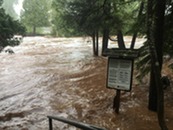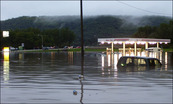|
Volume 15- September 2024
Flooding and Extreme Precipitation
Catastrophic Flooding. Extreme Storm Events. Raging Floods. Torrents of Water. Unprecedented Flooding. Extraordinary Rainfall. Historic Flooding.
These were some of the headlines this past summer, as flooding and extreme precipitation inundated the state of Minnesota. In this issue of the Reader, we are highlighting some of the latest research and efforts that explore relationships between extreme precipitation, heat events and sedimentation, and showcasing upcoming updates to the national precipitation frequency standard. This field is saturated with additional resources that may be of interest: NASA has released a publication and associated data - with great visualizations - on the water cycle extremes and changing intensity of hydroclimatic extreme events. Just this year, the Northern Research Station, USDA Climate Hubs, and Northern Institute of Applied Climate Science hosted a webinar series in Changing Hydrology, Changing Landscapes that you can listen in on. Finally, the Minnesota Department of Natural Resources Climatology Office detailed the extreme rainfall in northeastern Minnesota on June 18 and in southern Minnesota during June 20-22, and the exceptionally wet June that resulted.
---
The Minnesota Research Reader is a collaboration between the Minnesota Department of Natural Resources and the U.S. Department of Agriculture Forest Service that provides a quick look at emerging research relevant to our work in the state of Minnesota.
We hope you enjoy the selection of articles in this month's edition of the Reader!

In this recent publication, Manas Khan and their research team explore the occurrence of compound or sequential events, specifically extreme precipitation preceded by extreme hot day events, in the Midwest. Results showed a strong linkage between extreme precipitation and extreme hot day events, and a higher intensity of extreme precipitation events preceded by an extremely hot day compared to the intensity of extreme precipitation events not preceded by an extremely hot day. The study evaluates future climate projections and the significance they may have on societal and economic impacts in the region.
Management Implications:
- Results indicate that extreme heat contributes to more extreme precipitation.
- These findings can provide important insights related to flood management under future climate change scenarios in the Upper Midwest.
- Central and Southern areas of Minnesota, in particular, showed a higher intensity of extreme precipitation events preceded by an extremely hot day.
- Social infrastructure, economic impacts on crop yields, and human health conditions are also susceptible to impacts from compound hazards.
|

Researchers Zihao Bian and their team with the USDA Forest Service Southern Research Station investigate the impacts of climate and land use changes on increased soil erosion and sedimentation concerns in the Mississippi River Basin. Utilizing the Dynamic Land Ecosystem Model, they found notable increased soil erosion and sediment yield driven by extreme precipitation in the Midwest. This study highlights the increasing influences of extreme climate in affecting soil erosion and sedimentation, thus, water quality.
Management Implications:
- The article supports the importance of utilizing best management practices in agricultural and forested land, in addition to reforestation of agricultural lands where possible, to reduce soil erosion and sediment transport to waterways.
- Results from the regional process-based modeling indicate that an increase in sediment yield between 1980 and 2018 has been driven mainly by extreme precipitation.
- Managers may want to revisit existing forest and cropland best management practices to confront the impacts of climate change on water quality in the Mississippi River Basin.
|

University of Colorado scientists Rory Laiho, Katja Friedrich and Andrew Winters examine both spatial and temporal analysis of the distribution and variability of all rain events and heavy rain events during the warm season of May–September in Minnesota. This study addresses a gap in information about heavy precipitation in Minnesota and provides heavy rainfall analyses useful for climate-related planning.
Management Implications:
- Warm season heavy rainfall in Minnesota can lead to flooding with serious impacts on life and infrastructure.
- Heavy rain event region-based analyses showed monthly peaks for frequency in July–August, accumulation in July, and event hours in June–July and September.
- Future study of the relationship between meteorological drivers and heavy rainfall is intended to help identify patterns leading to heavy rain events and to enhance predictability of such events in climate modeling for operational forecasting during Minnesota’s warm season.
|

The standard resource for extreme precipitation frequencies referenced by engineers, climatologists, and hydrologists throughout the United States is being updated to account for the effect of rising global temperatures on the observed and projected hydroclimate. The current precipitation frequency resource, NOAA Atlas 14, is based entirely on observed data, which implicitly treats the climate as static or "stationary." NOAA Atlas 15 will address these shortcomings by accounting for the non-stationarity (or changes) in both the observed and projected climate. Observations will be updated into the 2020s, assessed for ongoing trends, and combined with climate projections for different greenhouse gas scenarios, yielding two volumes of values that reflect the changing nature of precipitation extremes.
Management Implications:
- Engineers designing our infrastructure will be able to use precipitation design values that reflect changes in hydroclimatic extremes.
- Roads, properties, and hydrologic infrastructure utilizing these newer precipitation design values will remain better protected under a changing climate.
- Climatologists will be able to describe how sizes and frequencies of precipitation extremes, like the 1% probability rainfall (commonly referred to as the "100-year storm"), are projected to change over time.
|
|